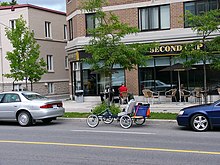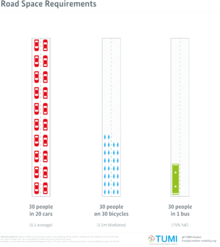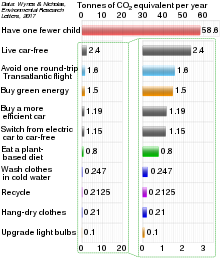San Francisco Critical Mass in 2005.
The car-free movement is a broad, informal, emergent network of individuals and organizations, including social activists, urban planners, transportation engineers and others, brought together by a shared belief that large and/or high-speed motorized vehicles (cars, trucks, tractor units, motorcycles, etc.)
are too dominant in most modern cities. The goal of the movement is to
create places where motorized vehicle use is greatly reduced or
eliminated, by converting road and parking space to other public uses and rebuilding compact urban environments where most destinations are within easy reach by other means, including walking, cycling, public transport, personal transporters, and mobility as a service.
Context
A quadracycle parked on a Canadian urban street between cars
Before the twentieth century, cities and towns were normally compact,
containing narrow streets busy with human activity. In the early
twentieth century, many of these settlements were adapted to accommodate
the car with wider roads, more car parking spaces, and lower population densities, with space between urban buildings reserved for automotive use. Lower population densities meant urban sprawl with longer distances between places. The low cost of use brought traffic congestion
which made older transport unattractive or impractical, and created the
conditions for more traffic and sprawl; the car system was
"increasingly able to 'drive' out competitors, such as feet, bikes,
buses and trains". This process led to changes in urban form and living patterns that offered little opportunity for people without a car.
Some governments have responded with policies and regulations aimed at reversing auto dependency by increasing urban densities, encouraging mixed use development and infill, reducing space allocated to private cars, increasing walkability, supporting cycling and other alternative vehicles similar in size and speed, and public transport. Globally, urban planning
is evolving in an effort to increase public transport and non-motorized
transport modal shares and shift away from private transport oriented
development. Cities like Hong Kong developed a highly integrated public
transportation system which effectively reduced the use of private
transport. In contrast with private automotive travel, car sharing,
where people can easily rent a car for a few hours rather than own one,
is emerging as an increasingly important element for urban
transportation.
Urban design
Passenger Capacity of different Transport Modes
Road Space Requirements
Proponents of the car-free movement focus on both sustainable and public transport (bus, tram, etc.) options and on urban design, zoning, school placement policies, urban agriculture, telecommuting
options, and housing developments that create proximity or access so
that long distance transportation becomes less of a requirement of daily
life.
New urbanism is an American urban design movement that arose in the early 1980s. Its goal has been to reform all aspects of real estate development and urban planning, from urban retrofits to suburban infill. New urbanist neighborhoods are designed to contain a diverse range of housing and jobs, and to be walkable. Other, more auto-oriented cities are also making incremental changes to provide transportation alternatives through Complete streets improvements.
World Squares for all is a scheme to remove much of the traffic from major squares in London, including Trafalgar Square and Parliament Square.
Car-free cities are, as the name implies, entire cities (or at least the inner parts thereof) which have been made entirely car-free.
Car-free zones are areas of a city or town where the use of cars is prohibited or greatly restricted.
To make the car-free zones/cities, (movable and/or stationary) traffic bollards and other barriers are often used to deny car access.
Living streets and complete streets
prioritize the needs of users of the street as a whole over those of
car drivers. They are designed to be shared by pedestrians, playing
children, bicyclists, and low-speed motor vehicles.
The ring road around Amsterdam (shown in red). At exits of ring roads such as this, distribution centers can be set up.
Distribution centers allow easy restocking of supermarkets, outlet stores, restaurants, and more in city centers. They rely on tractor units to unload their cargo in the suburban distribution center.
The products are then placed in a small truck (sometimes electrically powered), freight bicycle, or other vehicle to bridge the last mile
to the destination in the city center. Besides offering advantages to
the population (increased safety due to truck drivers having less blind spots,
reduced noise/traffic, reduced tailpipe emissions, and more), it also
offers financial advantage for the companies, as tractor units require a
lot of time to bridge this last mile (they lack agility and consume
much fuel in congested streets).
The method above however still doesn't reduce car use inside
non-car-free city centers (customers often use cars to fetch their
groceries or appliances from city stores, since they have so much
storage space). This problem is solved by means of online food ordering
systems, which allow customers to order online, and then have it
delivered to their doorstep by the supermarket or store itself, through bicycle couriers (using freight bicycles), electric delivery robots and delivery vans.
Delivery vans allow to take along more cargo and deliver to several
customers on a same trip. These food ordering systems could provide for a
smooth transition for those cities that wish to become car-free as it
can reduce both personal car use and personal car demand in cities.
At the outskirts of towns, between the exits of the rings roads,
and the car-free zones in the city center themselves, additional car
parking lots can be added, generally in the form of underground car
parks (to avoid it taking up surface space).
Careful placement of these car-parking lots is needed though, ensuring
that they are made far enough from the city centers (and closer to the
ring roads) to avoid them attracting more cars to the city center. In
some instances, near these car parking lots, Park and ride public transport (i.e. bus) stops are foreseen, or bicycle-sharing systems are present.
Community bicycle programs
provide bicycles within an urban environment for short term use. The
first successful scheme was in the 1960s in Amsterdam and can now be
found in many other cities with 20,000 bicycles introduced to Paris in
2007 in the Vélib' scheme.
Dockless bike share systems have recently appeared in the United
States and provide more convenience for people wanting to rent a bike
for a short time period.
Advocacy groups
The Campaign for Better Transport
(formerly known as Transport2000) was formed in 1972 in Britain to
challenge proposed cuts in the British rail network and since then has
promoted public transport.
Car Free Walks is a UK-based website encouraging walkers to use public transport to reach the start and end of walks, rather than using a car.
Activism groups
Road protests in the United Kingdom
rose to prominence in the early 1990s in response to a major road
building program both in urban communities and also rural areas.
Reclaim the Streets,
a movement formed in 1991 in London, "invaded" major roads, highway or
freeway to stage parties. While this may obstruct the regular users of
these spaces such as car drivers and public bus riders, the philosophy
of RTS is that it is vehicle traffic, not pedestrians, who are causing
the obstruction, and that by occupying the road they are in fact opening
up public space.
In Flanders, the organization Fietsersbond has called upon the government to ban tractor units in city centers.
Critical Mass
rides emerged in 1992 in San Francisco where cyclists take to the
streets en masse to dominate the traffic, using the slogan "we are
traffic." The ride was founded with the idea of drawing attention to how
unfriendly the city was to bicyclists. The movement has grown to include events in major metropolitan cities around the world.
The World Naked Bike Ride
was born in 2001 in Spain with the first naked bike rides, which then
emerged as the WNBR in 2004 a concept which rapidly spread through
collaborations with many different activist groups and individuals
around the world to promote bicycle transportation, renewable energy,
recreation, walkable communities, and environmentally responsible,
sustainable living.
Parking Days started in 2005 when REBAR,
a collaborative group of creators, designers and activists based in San
Francisco, transformed a metered parking spot into a small park
complete with turf, seating, and shade and by 2007 there were 180 parks in 27 cities around the world.
Official events
Car Free Days
are official events with the common goal of taking a fair number of
cars off the streets of a city or some target area or neighborhood for
all or part of a day, in order to give the people who live and work
there a chance to consider how their city might look and work with
significantly fewer cars. The first events were organized in Reykjavík
(Iceland), Bath (UK) and La Rochelle (France) in 1995.
Ciclovía is a similar event in many cities that places a large emphasis on cycling
as an alternative to auto travel. The event originated in Bogotá,
Colombia in 1974. Now, Bogotá holds weekly ciclovías that turn the
streets into giant car-free celebrations complete with stages set up in
city parks with aerobics instructors, yoga teachers, and musicians
leading people through various performances. The event has inspired
similar celebrations globally.
In town, without my car!
is an EU campaign and day every autumn (Northern Hemisphere) for an
increased use of vehicles other than the car. It has since spread beyond
the EU, and in 2004 more than 40 countries participated.
World Urbanism Day was founded in 1949 in Buenos Aires and is celebrated in more than 30 countries on four continents each November 8.
Towards Car-free Cities is the annual conference of the World Car-free Network
and provides a focal point for diverse aspects of the emerging global
car-free movement. The conference has been held in major cities around
the world, including Portland, Oregon, United States in 2008 (its first
time in North America), and has also been in Istanbul, Turkey; Bogota,
Colombia; Budapest, Hungary; Berlin, Germany; Prague, Czech Republic;
Timisoara, Romania; and Lyon, France. The conference series attempts to
bridge the gap between many of the diverse people and organizations
interested in reducing urban dependence on the automobile.
Transportation Alternative's Annual Commuter Race pits a
bicyclist against both a subway rider and a cab rider in a race from
Queens to Manhattan. The Fifth Annual Commuter race took place in May
2009, where bicyclist Rachel Myers beat straphanger Dan Hendrick and cab
rider Willie Thompson to make it the fifth year the contestant on the
bicycle won. Myers took the 2009 title with a time of 20 minutes and 15
seconds to make the 4.2 mile trek from Sunnyside, Queens to Columbus
Circle in Manhattan. Hendrick showed up 15 minutes later off the subway
and Thompson arrived via cab nearly a half-hour after that.
Transportation Alternatives is a group that "seeks to change New York
City's transportation priorities to encourage and increase
non-polluting, quiet, city-friendly travel and decrease—not ban—private
car use. [They] seek a rational transportation system based on a 'Green
Transportation Hierarchy,' which gives preference to modes of travel
based on their benefits and costs to society. To achieve its goals, T.A.
works in five areas: Bicycling, Walking and Traffic Calming, Car-Free
Parks, Safe Streets and Sensible Transportation." The 2009 Commuter Race
came on the heels of a Times Square traffic ban in NYC that drew
national media attention.
Car-free development
Definitions and types
There
are many areas of the world where people have always lived without
cars, because no road access is possible, or none has been provided. In
developed countries these include islands and some historic
neighborhoods or settlements, the largest example being the canal city
of Venice. The term carfree development implies a physical change - either new building or changes to an existing built area.
Melia et al. (2010) define car-free development as follows:
Car-free developments are residential or mixed use developments which:
- Normally provide a traffic-free immediate environment, and:
- Offer no parking or limited parking separated from the residence, and:
- Are designed to enable residents to live without owning a car.
This definition (which they distinguish from the more common "low car
development") is based mainly on experience in Northwestern Europe,
where the movement for car-free development began. Within this
definition three types are identified:
- Vauban model
- Limited Access model
- Pedestrian zones with residential population
Vauban
Vauban, Freiburg, Germany
is according to this definition, the largest car-free development in
Europe, with over 5,000 residents. Whether it can be considered car-free
is open to debate: many local people prefer the term "stellplatzfrei" -
literally "free from parking spaces" to describe the traffic management
system there. Vehicles are allowed down the residential streets at
walking pace to pick up and deliver but not to park, although there are
frequent infractions. Residents of the stellplatzfrei areas must sign an
annual declaration stating whether they own a car or not. Car owners
must purchase a place in one of the multi-storey car parks
on the periphery, run by a council-owned company. The cost of these
spaces – €17,500 in 2006, plus a monthly fee – acts as a disincentive to
car ownership.
Limited access type
The
more common form of car free development involves some sort of physical
barrier, which prevents motor vehicles from penetrating into a car-free
center.
Melia et al.
describe this as the "Limited Access" type.
In some cases such as Stellwerk 60 in Cologne, there is a removable
barrier, controlled by a residents' organizations. In others cases, such
as in Waterwijk, vehicular access is only available from the exterior.
Pedestrian zones
Whereas the first two models apply to newly built car free
developments, most pedestrianized areas have been retro-fitted.
Pedestrian zones may be considered car-free developments where they
include a significant population and a low rate of vehicle ownership per
household. The largest example in Europe is Groningen, Netherlands which had a city centre population of 16,500 in 2008.
Benefits and problems
Reduction in one's carbon footprint for various actions
Several studies have been done on European car free developments. The most comprehensive was conducted in 2000 by Jan Scheurer. Other more recent studies have been made of specific car-free areas such as Vienna's Florisdorf car-free development.
The main benefits found for car free developments (summarized in Melia et al. 2010) found in the various studies are:
- very low levels of car use, resulting in much less traffic on surrounding roads
- high rates of walking and cycling
- more independent movement and active play amongst children
- less land taken for parking and roads - more available for green or social space
The main problems related to parking management. Where parking is
not controlled in the surrounding area, this often results in complaints
from neighbors about overspill parking.






